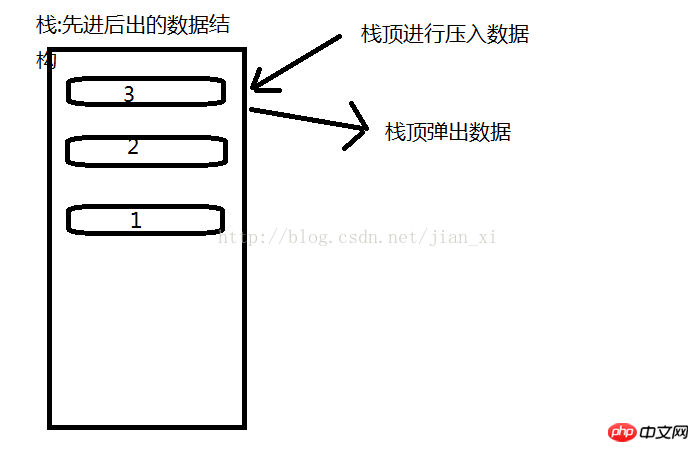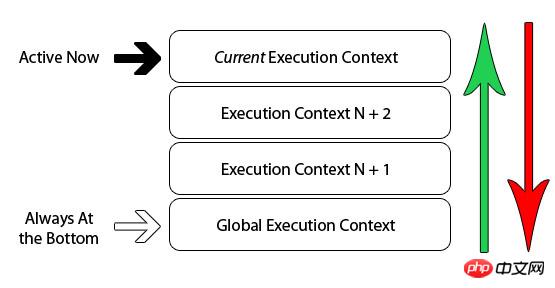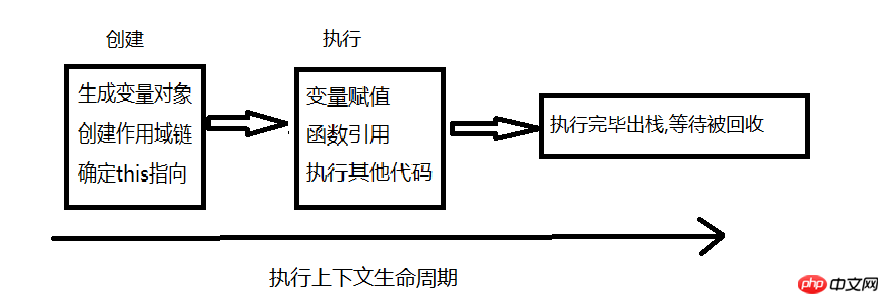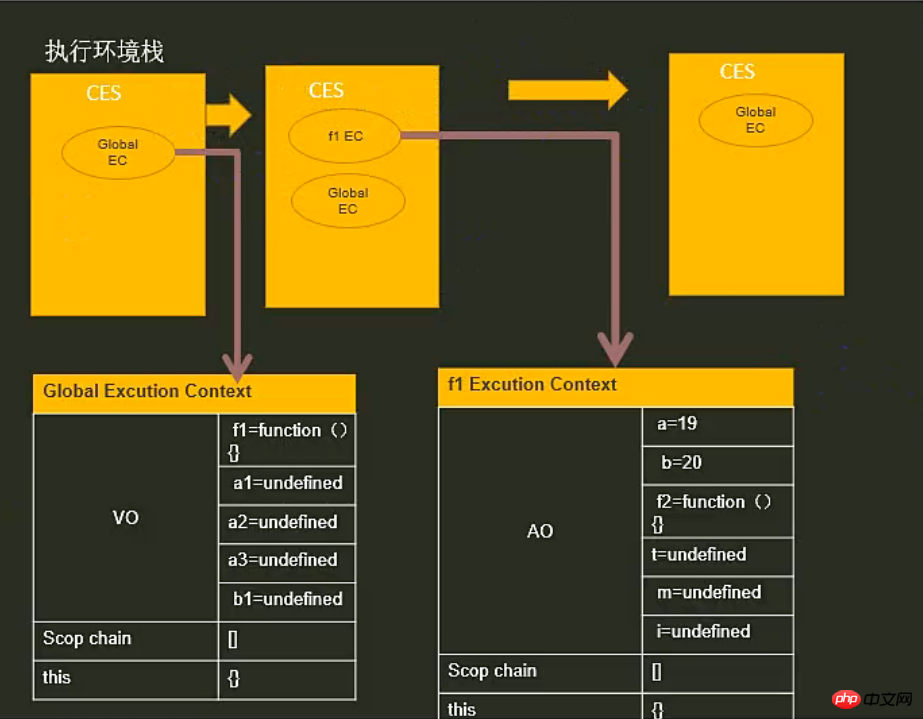Detailed description of JavaScript execution context
This article talks about JavaScript How to execute context. If you don’t know about JavaScript execution context or are interested in JavaScript execution context, then let’s take a look at this article together. Okay, nonsense Let’s talk less and get to the point
Background: In interviews, we often encounter problems such as function and variable promotion, scope, etc. If we want to understand its principles in depth, we must first understand Understand the concepts of function execution context and execution context stack.
Once again, let’s introduce the data structure of the stack:

##To sum it up in one sentence: New data is pushed in from the top of the stack, and pop-up data is also popped from the top of the stack, which is what we call the magazine principle.
1. Execution Context
The execution context can be understood as the current The execution environment of the code, which forms a scope. The running environment in JavaScript roughly includes three situations.
Global environment: JavaScript code will first enter this environment when running
Function environment: When the function is called and executed, it will Enter the current function to execute the code
eval (not recommended, can be ignored)
2. Execution Environment Stack (Execution Context Stack)
JavaScript is executed on a single thread, so all code is queued for execution. The bottom of the stack is always the global context, and the top of the stack is the current execution context. When the browser starts to execute global code, it first creates a unique global execution context and pushes it to the top of the execution stack (it occurs when the browser is closed) Stack). When the execution of a function
is not entered, a new function execution context will be created and pushed to the top of the execution stack accordingly. After the current function is completed, the execution of the current function The context is popped from the top of the stack and waits for garbage collection.
3. Execution context’s life cycle

##Total life cycle: Create-->Execute-->Pop the stack and wait for destruction
 Creation phase
Creation phase
##A Create variable object: first initialize the function Parametersarguments, initialization function declaration, initialization variable (undefined). The
priorityof a function is higher than that of a variable. If the variable has the same name as the function name, the variable will be ignored. a
Creates arguments object, checks context, initializes parameter names and values and creates a copy of the reference.
##b Scan the context for function declarations (not function expressions)
1.Every time a function is found, create an attribute on the variable object -----to be precise, it is the name of the function---the attribute value is A reference to the address of this function in memory.
2.If the above function name already exists under variableObject, the corresponding attribute value will be overwritten by the new reference. c Scan the context for variable declarations 1. Every time a variable declaration is found, an attribute is created on the variable object---the variable name character, and the value of the variable is initialized to undefined d. Determine the pointer of this within the context B Create a role Domain chain
Execution phase: Execution of variable assignment, code execution Recycling phase: The execution context stack waits for the garbage collection mechanism to recycle the context Case: (The following code is used to illustrate the working principle of the execution context stack) Environment stack diagram: ##If you don’t know much about it yet, you can easily master both sides by yourself! Front-end Advanced (2): Execution Context Diagram JavaScript Variable Object 2: VO in different execution contexts Front-end Basic Advanced ( 2): Execution contextDetailed illustration //变量声明
var a1 = 9,
a2 = 8,
a3 = "sss",
b1 = {name:"xixi"};
//函数调用
a1 = f1(a1,a2);
//函数声明
function f1(a,b){
//f1函数的执行上下文
/*
1.扫描参数: a = 9 b = 8
2.扫描函数声明 f2 = function(){}
3.扫描变量声明 t = undefined , m = undefined , i = undefined
*/
var t = 0,
m = 10;
for(var i=0;i<a;i++){
console.log(i);
}
function f2(){
console.log("f2");
}
return a+b;
}
Related recommendations:
The above is the detailed content of Detailed description of JavaScript execution context. For more information, please follow other related articles on the PHP Chinese website!

Hot AI Tools

Undresser.AI Undress
AI-powered app for creating realistic nude photos

AI Clothes Remover
Online AI tool for removing clothes from photos.

Undress AI Tool
Undress images for free

Clothoff.io
AI clothes remover

AI Hentai Generator
Generate AI Hentai for free.

Hot Article

Hot Tools

Notepad++7.3.1
Easy-to-use and free code editor

SublimeText3 Chinese version
Chinese version, very easy to use

Zend Studio 13.0.1
Powerful PHP integrated development environment

Dreamweaver CS6
Visual web development tools

SublimeText3 Mac version
God-level code editing software (SublimeText3)

Hot Topics
 1376
1376
 52
52
 How to implement an online speech recognition system using WebSocket and JavaScript
Dec 17, 2023 pm 02:54 PM
How to implement an online speech recognition system using WebSocket and JavaScript
Dec 17, 2023 pm 02:54 PM
How to use WebSocket and JavaScript to implement an online speech recognition system Introduction: With the continuous development of technology, speech recognition technology has become an important part of the field of artificial intelligence. The online speech recognition system based on WebSocket and JavaScript has the characteristics of low latency, real-time and cross-platform, and has become a widely used solution. This article will introduce how to use WebSocket and JavaScript to implement an online speech recognition system.
 Essential tools for stock analysis: Learn the steps to draw candle charts with PHP and JS
Dec 17, 2023 pm 06:55 PM
Essential tools for stock analysis: Learn the steps to draw candle charts with PHP and JS
Dec 17, 2023 pm 06:55 PM
Essential tools for stock analysis: Learn the steps to draw candle charts in PHP and JS. Specific code examples are required. With the rapid development of the Internet and technology, stock trading has become one of the important ways for many investors. Stock analysis is an important part of investor decision-making, and candle charts are widely used in technical analysis. Learning how to draw candle charts using PHP and JS will provide investors with more intuitive information to help them make better decisions. A candlestick chart is a technical chart that displays stock prices in the form of candlesticks. It shows the stock price
 Recommended: Excellent JS open source face detection and recognition project
Apr 03, 2024 am 11:55 AM
Recommended: Excellent JS open source face detection and recognition project
Apr 03, 2024 am 11:55 AM
Face detection and recognition technology is already a relatively mature and widely used technology. Currently, the most widely used Internet application language is JS. Implementing face detection and recognition on the Web front-end has advantages and disadvantages compared to back-end face recognition. Advantages include reducing network interaction and real-time recognition, which greatly shortens user waiting time and improves user experience; disadvantages include: being limited by model size, the accuracy is also limited. How to use js to implement face detection on the web? In order to implement face recognition on the Web, you need to be familiar with related programming languages and technologies, such as JavaScript, HTML, CSS, WebRTC, etc. At the same time, you also need to master relevant computer vision and artificial intelligence technologies. It is worth noting that due to the design of the Web side
 WebSocket and JavaScript: key technologies for implementing real-time monitoring systems
Dec 17, 2023 pm 05:30 PM
WebSocket and JavaScript: key technologies for implementing real-time monitoring systems
Dec 17, 2023 pm 05:30 PM
WebSocket and JavaScript: Key technologies for realizing real-time monitoring systems Introduction: With the rapid development of Internet technology, real-time monitoring systems have been widely used in various fields. One of the key technologies to achieve real-time monitoring is the combination of WebSocket and JavaScript. This article will introduce the application of WebSocket and JavaScript in real-time monitoring systems, give code examples, and explain their implementation principles in detail. 1. WebSocket technology
 How to implement an online reservation system using WebSocket and JavaScript
Dec 17, 2023 am 09:39 AM
How to implement an online reservation system using WebSocket and JavaScript
Dec 17, 2023 am 09:39 AM
How to use WebSocket and JavaScript to implement an online reservation system. In today's digital era, more and more businesses and services need to provide online reservation functions. It is crucial to implement an efficient and real-time online reservation system. This article will introduce how to use WebSocket and JavaScript to implement an online reservation system, and provide specific code examples. 1. What is WebSocket? WebSocket is a full-duplex method on a single TCP connection.
 How to use JavaScript and WebSocket to implement a real-time online ordering system
Dec 17, 2023 pm 12:09 PM
How to use JavaScript and WebSocket to implement a real-time online ordering system
Dec 17, 2023 pm 12:09 PM
Introduction to how to use JavaScript and WebSocket to implement a real-time online ordering system: With the popularity of the Internet and the advancement of technology, more and more restaurants have begun to provide online ordering services. In order to implement a real-time online ordering system, we can use JavaScript and WebSocket technology. WebSocket is a full-duplex communication protocol based on the TCP protocol, which can realize real-time two-way communication between the client and the server. In the real-time online ordering system, when the user selects dishes and places an order
 PHP and JS Development Tips: Master the Method of Drawing Stock Candle Charts
Dec 18, 2023 pm 03:39 PM
PHP and JS Development Tips: Master the Method of Drawing Stock Candle Charts
Dec 18, 2023 pm 03:39 PM
With the rapid development of Internet finance, stock investment has become the choice of more and more people. In stock trading, candle charts are a commonly used technical analysis method. It can show the changing trend of stock prices and help investors make more accurate decisions. This article will introduce the development skills of PHP and JS, lead readers to understand how to draw stock candle charts, and provide specific code examples. 1. Understanding Stock Candle Charts Before introducing how to draw stock candle charts, we first need to understand what a candle chart is. Candlestick charts were developed by the Japanese
 JavaScript and WebSocket: Building an efficient real-time weather forecasting system
Dec 17, 2023 pm 05:13 PM
JavaScript and WebSocket: Building an efficient real-time weather forecasting system
Dec 17, 2023 pm 05:13 PM
JavaScript and WebSocket: Building an efficient real-time weather forecast system Introduction: Today, the accuracy of weather forecasts is of great significance to daily life and decision-making. As technology develops, we can provide more accurate and reliable weather forecasts by obtaining weather data in real time. In this article, we will learn how to use JavaScript and WebSocket technology to build an efficient real-time weather forecast system. This article will demonstrate the implementation process through specific code examples. We




